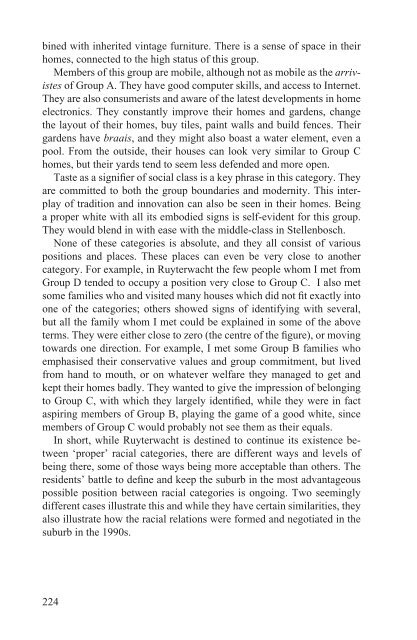The Making of a Good White - E-thesis - Helsinki.fi
The Making of a Good White - E-thesis - Helsinki.fi
The Making of a Good White - E-thesis - Helsinki.fi
You also want an ePaper? Increase the reach of your titles
YUMPU automatically turns print PDFs into web optimized ePapers that Google loves.
ined with inherited vintage furniture. <strong>The</strong>re is a sense <strong>of</strong> space in their<br />
homes, connected to the high status <strong>of</strong> this group.<br />
Members <strong>of</strong> this group are mobile, although not as mobile as the arrivistes<br />
<strong>of</strong> Group A. <strong>The</strong>y have good computer skills, and access to Internet.<br />
<strong>The</strong>y are also consumerists and aware <strong>of</strong> the latest developments in home<br />
electronics. <strong>The</strong>y constantly improve their homes and gardens, change<br />
the layout <strong>of</strong> their homes, buy tiles, paint walls and build fences. <strong>The</strong>ir<br />
gardens have braais, and they might also boast a water element, even a<br />
pool. From the outside, their houses can look very similar to Group C<br />
homes, but their yards tend to seem less defended and more open.<br />
Taste as a signi<strong>fi</strong>er <strong>of</strong> social class is a key phrase in this category. <strong>The</strong>y<br />
are committed to both the group boundaries and modernity. This interplay<br />
<strong>of</strong> tradition and innovation can also be seen in their homes. Being<br />
a proper white with all its embodied signs is self-evident for this group.<br />
<strong>The</strong>y would blend in with ease with the middle-class in Stellenbosch.<br />
None <strong>of</strong> these categories is absolute, and they all consist <strong>of</strong> various<br />
positions and places. <strong>The</strong>se places can even be very close to another<br />
category. For example, in Ruyterwacht the few people whom I met from<br />
Group D tended to occupy a position very close to Group C. I also met<br />
some families who and visited many houses which did not <strong>fi</strong>t exactly into<br />
one <strong>of</strong> the categories; others showed signs <strong>of</strong> identifying with several,<br />
but all the family whom I met could be explained in some <strong>of</strong> the above<br />
terms. <strong>The</strong>y were either close to zero (the centre <strong>of</strong> the <strong>fi</strong>gure), or moving<br />
towards one direction. For example, I met some Group B families who<br />
emphasised their conservative values and group commitment, but lived<br />
from hand to mouth, or on whatever welfare they managed to get and<br />
kept their homes badly. <strong>The</strong>y wanted to give the impression <strong>of</strong> belonging<br />
to Group C, with which they largely identi<strong>fi</strong>ed, while they were in fact<br />
aspiring members <strong>of</strong> Group B, playing the game <strong>of</strong> a good white, since<br />
members <strong>of</strong> Group C would probably not see them as their equals.<br />
In short, while Ruyterwacht is destined to continue its existence between<br />
‘proper’ racial categories, there are different ways and levels <strong>of</strong><br />
being there, some <strong>of</strong> those ways being more acceptable than others. <strong>The</strong><br />
residents’ battle to de<strong>fi</strong>ne and keep the suburb in the most advantageous<br />
possible position between racial categories is ongoing. Two seemingly<br />
different cases illustrate this and while they have certain similarities, they<br />
also illustrate how the racial relations were formed and negotiated in the<br />
suburb in the 1990s.<br />
224
















